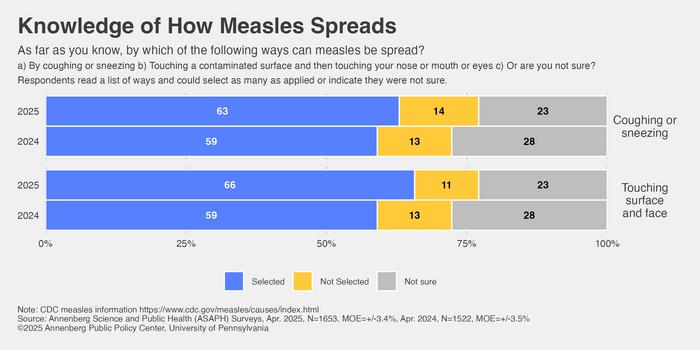
The United States is experiencing a significant resurgence of measles in 2025, marking the second-highest incidence of cases since the disease was declared eliminated domestically in 2000. Measles elimination refers to the absence of continuous disease transmission for more than 12 months within a defined geographic area, a milestone the U.S. achieved after intense vaccination efforts. However, recent data from the Centers for Disease Control and Prevention (CDC) indicate that over 1,000 confirmed U.S. cases of measles have already been reported this year, accompanied by three confirmed fatalities. Given that underreporting is common with measles, experts assert that these figures likely understate the true extent of the outbreak. Historically, from 2000 to 2024, the nation averaged about 180 measles cases annually, underscoring the alarming nature of this surge.
Despite widespread public awareness of how measles transmits, many Americans lack an accurate understanding of the severity and potential complications associated with the disease. The Annenberg Public Policy Center’s latest survey, conducted in April 2025 with 1,653 adult participants, reveals this disconnect starkly. The data show that while most respondents can identify the common transmission routes of measles, fewer grasp the substantial risks that measles poses, especially to vulnerable populations such as pregnant women. This gap in knowledge is concerning amid declining vaccination rates and the geographical spread of measles cases across 31 states.
Measles is one of the most contagious viral diseases, transmitted primarily through respiratory droplets expelled when an infected person coughs or sneezes. Additionally, the virus can persist on contaminated surfaces for several hours, allowing indirect transmission when individuals touch these surfaces and subsequently contact their eyes, nose, or mouth. The survey detected increased public recognition of this pathway, with two-thirds of Americans correctly acknowledging surface contact as a transmission route, a notable rise from previous years. Understanding these transmission modalities is crucial in implementing effective prevention measures and reducing outbreak propagation.
The disease’s incubation period—the span between exposure and symptom onset—is critical for controlling spread but remains poorly understood by the general public. Measles can be contagious four days before the characteristic rash appears, a period during which individuals may unknowingly infect others. The survey found that only 14% of respondents accurately identified this contagious pre-rash period, while a majority remained uncertain. This knowledge gap may hinder timely quarantine measures and exacerbate outbreak dynamics.
Vaccination remains the cornerstone of measles control. The measles, mumps, and rubella (MMR) vaccine is recommended in two doses: the first between 12 and 15 months of age and the second between 4 and 6 years. The CDC reports that the vaccine is approximately 97% effective in preventing measles for those fully vaccinated and exposed to the virus. Despite this, vaccine hesitancy has surged, partially fueled by misinformation linking the MMR vaccine to autism—a claim conclusively debunked by scientific research. Although 67% of Americans now understand that the vaccine does not cause autism, this figure has declined from 74% in 2021, revealing a troubling trend in public perception.
Public trust in the safety and efficacy of the MMR vaccine remains broadly positive, with 83% of survey respondents affirming that its benefits outweigh potential risks. This support, although slightly diminished since 2023, remains robust and reflects the longstanding impact of vaccination in preventing severe measles complications such as pneumonia, encephalitis, and death. Nonetheless, the erosion in vaccine confidence requires urgent addressing through public education campaigns to sustain herd immunity thresholds critical for interrupting measles transmission.
Among policymaking arenas, the debate over mandatory vaccination for school children has garnered increasing public backing. According to the survey, 70% of Americans endorse the requirement that healthy children be vaccinated to attend public schools, citing the protection of unvaccinated individuals who may be vulnerable to severe disease. This is a marked increase from 63% support in 2023. Conversely, only 18% advocate for parental choice in vaccine decisions when such choice may elevate risks to the larger community. These data highlight societal recognition of vaccination as both an individual and collective responsibility.
The risk of measles infection during pregnancy is particularly consequential, yet remains poorly understood by the American public. Measles during pregnancy can cause serious complications, including premature labor and low birthweight infants. However, a majority (57%) of survey participants admitted uncertainty about these outcomes. Only about a third identified low birthweight and early delivery as pregnancy-related complications. Alarmingly, some respondents mistakenly believed unrelated conditions like diabetes could result from measles during pregnancy, underscoring misinformation challenges.
The CDC’s vaccination recommendations are explicit: women planning pregnancy should receive the MMR vaccine at least one month prior to conception, as the live attenuated vaccine is contraindicated during pregnancy due to theoretical risks to the fetus. Despite these guidelines, only 15% of survey respondents correctly knew that the MMR vaccine is recommended before but not during pregnancy. Enhanced communication strategies targeting reproductive-aged individuals could mitigate this critical knowledge deficit and protect maternal and infant health.
Public perceptions about measles symptoms and hospitalization also reveal considerable inaccuracies. Official data estimate that 13% of measles cases result in hospitalization; the survey showed a matched 13% of respondents correctly estimated this value. However, a significant portion either underestimated or overestimated this figure or remained unsure. Similarly, awareness that approximately 10% of measles cases cause diarrhea diminished, with rising uncertainty noted compared to prior years. Such misunderstanding may impact individuals’ appreciation for the clinical severity of measles and their motivation to vaccinate.
Amid discussions about non-vaccine preventive treatments, claims were made attributing measles prevention to vitamin A and cod liver oil intake. These assertions were spotlighted by health officials in Texas during the recent outbreak. Scientific experts emphasize that while vitamin A supplementation may support recovery in measles patients by bolstering immune function, it cannot prevent the disease itself. The survey reflected public ambivalence, with nearly half unsure about the efficacy of these remedies, while only a small minority believed they conferred protection. Moreover, excessive vitamin A consumption bears risks, as evidenced by reports of liver damage in children receiving high doses.
This complex interplay between measles epidemiology, vaccination dynamics, public perceptions, and misinformation underscores the ongoing challenges in controlling infectious diseases in contemporary America. The Annenberg Public Policy Center’s April 2025 survey offers vital insights into knowledge gaps and attitudinal shifts that must be addressed by health authorities and communicators to safeguard public health effectively.
Subject of Research: Public knowledge and attitudes regarding measles transmission, vaccination, and associated risks in the United States during the 2025 measles outbreak.
Article Title: Rising Measles Cases in the U.S. Highlight Gaps in Public Knowledge and Vaccine Confidence
News Publication Date: 2025
Web References:
CDC measles data and vaccination guidelines: https://www.cdc.gov/measles/data-research/index.html
Annenberg Public Policy Center: https://www.annenbergpublicpolicycenter.org
CDC pregnancy and vaccination safety: https://www.cdc.gov/vaccines-pregnancy/moms-to-be/index.html
FactCheck.org on measles vaccine misinformation: https://www.factcheck.org/2025/03/rfk-jr-misleads-about-measles-vaccine-in-hannity-interview/
Image Credits: Annenberg Public Policy Center
Keywords: Measles, Infectious diseases, Viral infections, Vaccination, MMR vaccine, Public health, Pregnancy, Vaccine hesitancy, Measles complications
Tags: Annenberg Public Policy Center surveyCDC measles data 2025importance of childhood vaccinationsmeasles elimination historyMMR vaccine benefits and riskspublic perception of measles severityresurgence of measles in 2025U.S. measles outbreak statisticsunderreporting of measles casesunderstanding measles transmissionvaccination efforts in the U.S.vulnerable populations and measles





